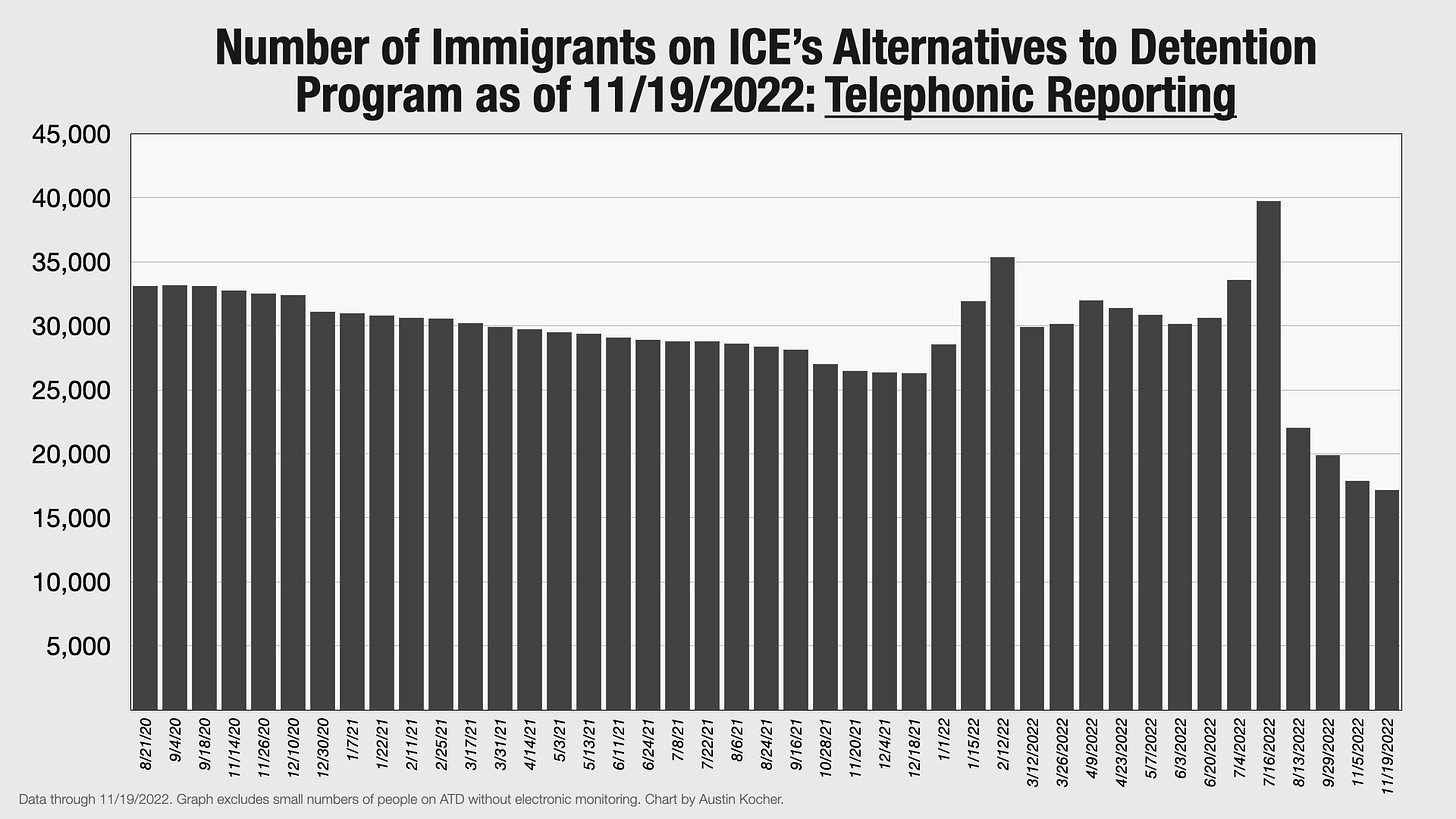Number of Immigrants on ICE's GPS Ankle Monitors Increased Rapidly Since August
After months of decline, ICE's use of ankle monitors grew from less than 15,000 to nearly 60,000 in the past four months.
Immigration and Customs Enforcement (ICE) is now tracking over a third of a million people on its alternatives to detention program according to data released by the agency online and also collected by TRAC.
The agency now officially tracks 343,038 people, although the total number of people affected by alternatives to detention is likely much higher since nearly a quarter of those cases (24%) are identified as family units. Moreover, the invasive nature of electronic monitoring means that anyone living in the same house as the individual(s) being monitored may also come under direct or indirect forms of monitoring.
As you know if you’ve been reading this newsletter (or if you skim the back issues here), I have spent much of the past year examining the implications of this rapid expansion in electronic monitoring. Of particular concern to me has been the use of SmartLINK, the smartphone-based technology that has enabled ICE to scale up this program so quickly.
I have spoken with many attorneys, organizers, policy advocates, and other researchers about ICE ATD program in general, and SmartLINK in particular, and the most common response is: SmartLINK is better than detention or ankle monitors, but is still concerning.
Although I have not spoken with DHS officials myself, the agency did hold a symposium on ATD recently (I was invited, but missed it due to fieldwork). Based on feedback from colleagues, it sounds like the agency views ATD as an essential and even untouchable program going forward. This is consistent with my working assumption that ICE plans to use ATD as a mass surveillance program (though I’m told they don’t like the term “surveillance”), and we should expect this to only continue to grow.
I recently had the good fortune (if you can put it that way) while in Brownsville, Texas, to see recently-arrived migrants get their SmartLINK smartphones as they were processed and then released near the bus station in the city. I was told by people who work with the migrants more directly that the smartphones are activated before they are released from Border Patrol’s custody and required to conduct their first virtual check-in once they arrive in the city where their sponsor lives and where they will have their cases heard.
It may also be the case that at their initial in-person check-in with ICE at the local ICE field office, that migrants are also required to begin using their own smartphones with BI’s SmartLINK app, and to turn over their government-issued phones so that they can be put back into circulation.

Despite all of my attention on SmartLINK, however, I’ve been surprised to see GPS ankle monitor usage shoot through the roof since August. I had speculated at one point that there might be some maximum number of GPS ankle monitors in circulation, around 30,000, since that was as high as ICE numbers seemed to go. And in fact, ICE’s numbers showed such a significant decline in ankle monitor use that I began to wonder if the agency was weening itself off of that technology.
Nope. In just the past four months, GPS usage has nearly quadrupled from less than 15,000 to almost 60,000. I might not have been wrong; ICE may have maxed out GPS capacity at some point, but BI (the company that makes ICE’s ankle monitors) might have produced a new shipment of ankle monitors. If anyone knows the answer to that, please share. But regardless, GPS ankle monitors are back with a vengeance.
Note: The Department of Homeland Security reached out to me after I published this article to inform me that ICE’s ATD data was inaccurate, and the actual number of people on ATD is closer to 8,000. Since TRAC maintains this data on its website, we will correct our public data tools. But given that ICE has repeatedly botched its public data releases, the process of fixing the issue will take some more fundamental problem solving.
I’ll post the graphs of each of the three technology types below so you can see the data for each technology altogether and individually. The graph of GPS ankle monitors is the last one.
Support public scholarship.
Thank you for reading. If you would like to support public scholarship and receive this newsletter in your inbox, click below to subscribe for free. And if you find this information useful, consider sharing it online or with friends and colleagues.







